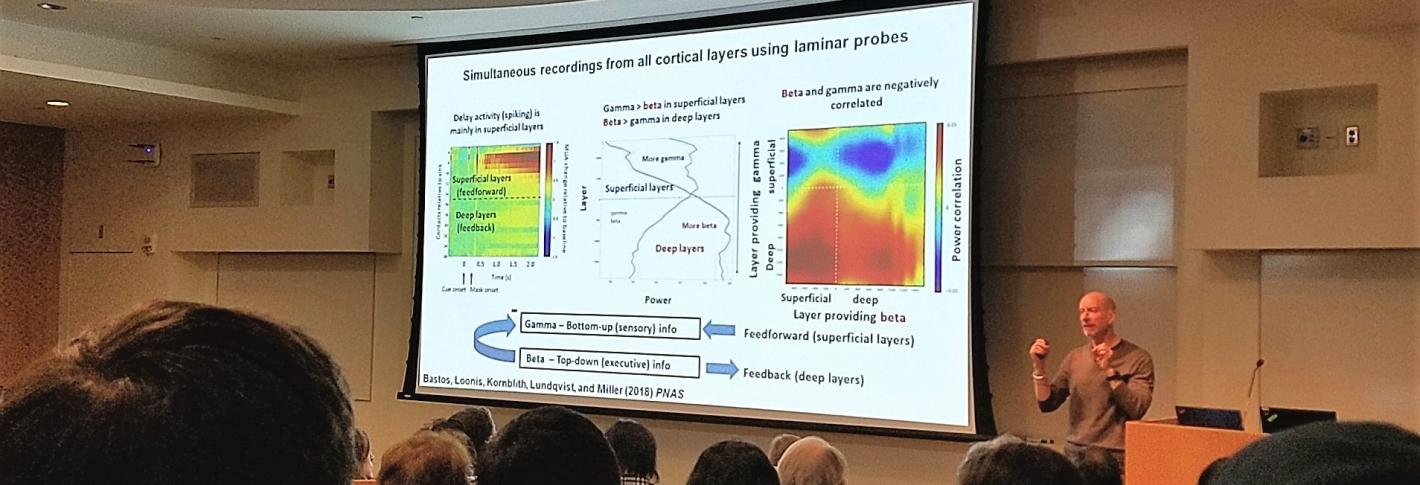Many roles for rhythms
For most of his talk, Singer explained how oscillations allow the brain to encode relations of neural activity. In a paper earlier this year as well, he argued how coordinating such connections is crucial for the brain to attend to specific sensations, to recognize patters and to make associations crucial to learning. In his talk proposed that oscillatory dynamics of the brain provide the high-dimensional space needed for storing and quickly retrieving large amounts of information.
In his turn at the podium, Picower Professor Earl Miller described a particularly useful form of storage and recall: working memory. He described a new model, detailed in a series of recent papers, in which beta waves representing our goals and priorities control the representation of sensory information by gamma waves, which gives us the freedom to control what we hold in mind.
“With working memory we can choose what to pay attention to, we can choose what to think about, we can choose when to respond,” Miller said. “When it comes to intelligent, goal-directed behavior, working memory is where the rubber meets the road.”
Boston University mathematician Nancy Kopell, whose work in modeling oscillations in the brain has influenced several of the other speakers, presented her own studies of working memory, in particular the role of specific beta rhythms. She also focused several flavors of oscillations – theta, beta and gamma, in the striatum region of the brain.
Annabelle Singer and Laura Colgin of the University of Texas at Austin, meanwhile, took the discussion of rhythms to spatial memory in the hippocampus. Singer talked about how the level of activity of rhythms called sharp-wave ripples, which are closely associated with gamma frequency waves, predict whether mice will successfully navigate around maze. Colgin, meanwhile, showed that by tracking distinct gamma frequencies among place cells, she could predict where mice were along a path (fast gamma) and where they were headed next (slow gamma). The reason for the frequency difference, she said, may be to prevent interference between place memory encoding and recall.
Three other speakers focused on the apparently pivotal role gamma plays in perception and attention in various parts of the cortex.
Pascal Fries of ESI presented evidence of a hierarchy of beta and gamma in tasks of visual perception and attention, including that the degree of gamma synchronization in the visual cortex predicts the speed of reaction time. Marie Carlén, a former postdoc in Tsai’s lab and now associate professor at the Karolinska Institute in Stockholm, Sweden, discussed her research showing that increasing gamma rhythms in parvalbumin (PV)-expressing interneurons in the prefrontal cortex (the mouse version of it) made the rodents more accurate in focusing their attention and noticing a stimulus. In some of her work Carlén collaborated with former MIT neuroscientist Christopher Moore, now a professor at Brown University. He also spoke at the Symposium, describing how persistent gamma rhythms in non-sensory, fast-spiking cells in the brain region responsible for the whiskers help mice increases their tactile sensitivity, perhaps by modulating the activity of pyramidal neurons.
In his discussion, Peter Jonas, a professor at the Institute for Science and Technology in Klosterneuburg, Austria, extended the functional importance of PV interneurons to the task of pattern separation, showing that the key to developing accurate models of the memory-sorting capability depended on understanding their connectivity patterns (In newly published results, Jonas also showed that the PV interneurons are quite energy efficient).
Restoring order in disorders
For all the abilities healthy rhythms sustain, there are clinical consequences for people in whom rhythms become unhealthy. The question, then, is whether restoring them, as Tsai and Annabelle Singer hypothesize, can provide a medical benefit. Two speakers from the University of California at San Francisco (UCSF) medical school showed how they hope to help patients.
Like Tsai and Singer, Jorge Palop, assistant professor of neurology at the UCSF, has observed gamma disruptions in AD model mice and human patients. One result, he notes, is that lack of gamma makes patients more susceptible to seizures early in the disease. His lab has found that deficiency in the ion channel protein Nav1.1 may be a target for therapy because evidence shows that restoring it, restores proper gamma rhythms and remedies the seizure-like hyperactivity.
Meanwhile, UCSF psychiatrist Vikaas Sohal focused on the role of deficient gamma rhythms in the prefrontal cortex in schizophrenia. With Kathleen Cho, a former student of Picower Professor Mark Bear, he has shown that the disruption depends specifically on PV interneurons and that stimulating them to entrain gamma helps schizophrenia model mice improve cognition – particularly keeping up with changes in the rules of a task.
In other words, Sohal said, disruption in gamma leads to a lack of cognitive flexibility. As other speakers observed as well, when the waves are working well, they endow us with a precious ability. When they aren’t, we lose it. Such peaks and troughs are a characteristic of waves and, as the day showed, their true power in our health.





